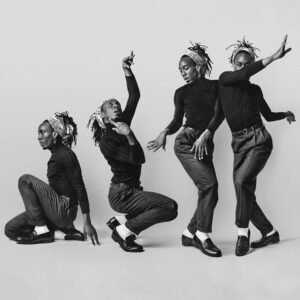Vogue Ballroom is a name that resonates with sophistication, culture, and a unique blend of artistic expression. Whether one is familiar with the world of fashion, dance, or the intricate web of subcultures that thrive within the LGBTQ+ community, the term “Vogue” likely strikes a chord. The Vogue Ballroom is not just a place but a phenomenon—a fusion of high fashion, intricate dance moves, and a celebration of individuality. In this article, we delve into the essence of the Vogue Ballroom, exploring its origins, cultural significance, and the vibrant community that sustains it.
The Origins of Vogue Ballroom
The origins of the Vogue Ballroom can be traced back to the Harlem Renaissance of the 1920s, a period of cultural rebirth for African Americans. During this time, ballroom culture began to take shape, providing a space for marginalized groups, particularly Black and Latinx LGBTQ+ individuals, to express themselves freely. The early ballrooms were safe havens where participants could showcase their talents, creativity, and identities without fear of judgment or persecution.
Voguing, the dance style that lies at the heart of Vogue Ballroom culture, emerged from this milieu. Inspired by the poses and elegance of high fashion models featured in magazines like Vogue, dancers began to incorporate these movements into their routines. Voguing evolved into a highly stylized dance form characterized by angular, linear, and precise movements, often mimicking the poses struck by models on the runway.
The Evolution of Vogue Ballroom
While the origins of Vogue Ballroom are rooted in the early 20th century, the culture truly began to flourish in the 1980s. This period saw the rise of ballroom houses—families of chosen kin, often led by a house “mother” or “father,” who mentored and supported members in both the ballroom scene and life in general. These houses, such as the House of LaBeija and the House of Xtravaganza, became central to the community, providing not only a sense of belonging but also fierce competition at ballroom events.
The 1980s also saw the popularization of voguing beyond the ballroom scene, largely due to the documentary Paris Is Burning (1990). Directed by Jennie Livingston, the film offered an intimate look into the lives of ballroom participants, highlighting their struggles, dreams, and the powerful sense of community that the ballroom scene provided. Paris Is Burning brought voguing and ballroom culture into the mainstream, influencing fashion, music, and pop culture.
Madonna’s 1990 hit song “Vogue” further catapulted the dance style into global consciousness. The music video, which featured iconic voguing moves, introduced the world to the elegance and artistry of the dance, solidifying its place in popular culture.
Cultural Significance of the Vogue Ballroom

The Vogue Ballroom is more than just a dance hall; it is a cultural institution that has played a pivotal role in the lives of many within the LGBTQ+ community, particularly people of color. The ballrooms serve as spaces where individuals can explore and express their identities, often in ways that society at large does not permit. In a world that frequently marginalizes queer people of color, the Vogue Ballroom is a site of resistance, empowerment, and liberation.
Ballroom events are known for their categories—competitions in which participants “walk” and perform in various themes. Categories can range from “Realness” (where participants present themselves as convincingly as possible in a particular gender or social role) to “Face” (where beauty and self-presentation are judged), and “Performance” (where voguing skills are showcased). These categories allow participants to embody different personas, play with gender norms, and assert their presence in a world that often tries to render them invisible.
Moreover, the Vogue Ballroom has become a space where fashion and creativity flourish. The outfits worn by participants are often elaborate, reflecting hours of work and incredible attention to detail. These garments are not just clothing but statements of identity, pride, and defiance. Fashion in the ballroom scene is a form of self-expression that transcends the runway, blending elements of haute couture with the everyday to create something entirely new and unique.
The Community Behind the Culture
At the heart of the Vogue Ballroom is a tightly-knit community built on mutual support, mentorship, and love. The concept of “houses” is central to this community, with each house functioning as a family unit. Members of a house support one another, both in and out of the ballroom, forming bonds that often last a lifetime.
The leadership within these houses is typically composed of the most experienced and respected members of the ballroom scene. These “mothers” and “fathers” guide their house members, helping them navigate the challenges of life while also preparing them for ballroom competitions. This mentorship is crucial, especially for young LGBTQ+ individuals who may not have support from their biological families.
The sense of belonging that comes from being part of a house is invaluable. For many, the ballroom community becomes a sanctuary, a place where they are not only accepted but celebrated for who they are. The support network provided by the ballroom scene has been life-saving for many, offering a sense of purpose, identity, and community in a world that can often feel hostile.
The Influence of Vogue Ballroom on Mainstream Culture
The impact of Vogue Ballroom on mainstream culture cannot be overstated. From fashion to music, film, and television, elements of ballroom culture have permeated various aspects of popular culture. Shows like RuPaul’s Drag Race and Pose have brought ballroom culture to new audiences, showcasing the artistry, drama, and humanity of the scene.
Fashion designers have also drawn inspiration from ballroom culture, incorporating its bold, expressive elements into their collections. The influence of voguing can be seen on runways around the world, where the exaggerated poses and dramatic flair of ballroom participants have left an indelible mark.
Conclusion
The Vogue Ballroom is a vibrant and vital part of the LGBTQ+ community, offering a space for self-expression, creativity, and community. Its roots in the Harlem Renaissance, its evolution through the decades, and its influence on mainstream culture all speak to its enduring power and significance. In the Vogue Ballroom, individuals are free to be themselves, to celebrate their identities, and to create art that reflects their lives and dreams. As the culture continues to evolve, it remains a beacon of resilience, beauty, and unapologetic self-expression.



